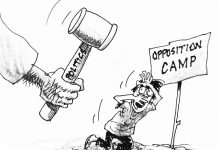Are you feeling the heat? Well, everybody is feeling the humid dry reality of Eastern Visayas! In fact, if Eastern Visayas is a brand of a beer we are the Eastern Visayas Super Dry!
As of early July 2025, Tacloban and much of Eastern Visayas have been experiencing a stretch of warm and humid weather with little to no rainfall. While exact data on the number of consecutive dry days isn’t publicly specified, forecasts and reports suggest that this dry spell has lasted several days to possibly over a week, with only isolated rain showers or localized thunderstorms occurring sporadically.
Primary reason for the dry conditions is a monsoon break—a temporary pause in the southwest monsoon (habagat), which typically brings rain to the region during this season. We have to take a closer look on what we are feeling, with the persistent heat. Here are some reasons;
Monsoon Break: The southwest monsoon is currently affecting only extreme northern Luzon, leaving Eastern Visayas with reduced moisture and rainfall.
Localized Thunderstorms: While these can still occur, they’re scattered and not enough to break the dry spell.
Low-Pressure Area (LPA): A weather disturbance was spotted east of Eastern Visayas, but it remains outside the Philippine Area of Responsibility and has a low chance of developing into a cyclone.
Seasonal Climate Patterns: Tacloban typically sees fewer rainy days in April and May, but August is usually wetter—so this dry spell is somewhat unusual for this time of year.
What can we do? To mitigate the heat and lack of rains?
1. Conserve Water
Limit usage: Use water wisely—shorten showers, fix leaks, and avoid unnecessary washing.
Reuse when possible: Collect water from laundry or dishwashing for cleaning floors or watering plants.
Store clean water: Keep emergency reserves in case of supply interruptions.
2. Protect Plants and Crops
Water early or late: Water gardens or crops during cooler hours to reduce evaporation.
Mulch soil: Use dried leaves or straw to retain moisture in the soil.
Shade sensitive plants: Use netting or temporary covers to reduce heat stress.
3. Stay Cool and Healthy
Hydrate often: Drink water regularly, even if you’re not thirsty.
Wear light clothing: Choose breathable fabrics like cotton.
Avoid peak heat: Stay indoors or in shaded areas between 10 AM and 3 PM.
4. Prevent Fire Hazards
Avoid open burning: Dry vegetation increases fire risk.
Clear surroundings: Remove dry leaves and debris near homes and farms.
Report smoke: Alert local authorities if you see signs of fire.
Lets pray for rain but lets also do things that will allow us to survive, the long super-dry spell!




